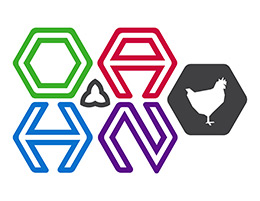Ontario Animal Health Network (OAHN)
Poultry Expert Network
Quarterly Producer Report
Management of flies on the farm
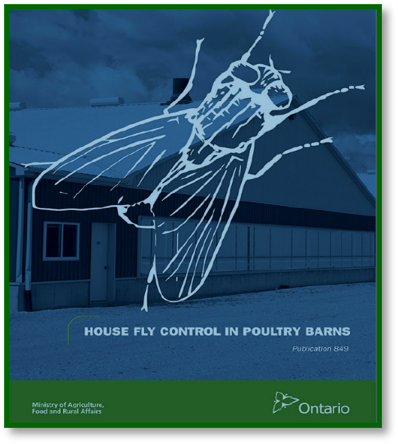
Every summer, farms have an ongoing challenge with fly populations. Complete eradication of flies is not possible, but population management can maintain the populations at an acceptable level as well as minimize the health risks for poultry and humans. Flies can carry or be mechanical vectors of multiple disease agents including bacteria (Salmonella, Pasteurella, Campylobacter, E. coli, botulism), viruses (avian influenza, Newcastle disease), parasites (coccidia, roundworms) and fungi. Understanding the fly lifecycle and environmental conditions promoting fly propagation goes a long way in implementing integrated pest management.
Flies have a life cycle that consists of 4 stages: eggs, larvae (maggots), pupae and adult flies. The length of the life cycle varies depending on the environmental conditions (e.g. heat, moisture, organic material) but can be as short as 7-10 days or as long as 2 months.
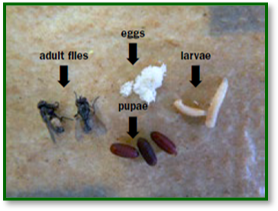
Adult flies can live 3-4 weeks and females can lay approximately 500 eggs in their lifetime. Female flies lay their eggs in batches of approximately 75-150 eggs on moist (50-85%), decaying organic materials. While adult flies are highly visible, they are only about 15% of the population. Most of the fly population exists in the less visible stages of eggs, larvae and pupae. Flies are most active between 20-25⁰C (68-75⁰F). At higher temperatures (>35⁰C/95⁰F) they will rest more and migrate outdoors. At temperatures <10⁰C/50⁰F adult flies can remain alive but dormant. Flies can overwinter Inside barns having appropriate climate. Flies are active outside from early spring to the beginning of winter, but one can have a fly bloom in a barn in January if the conditions are right.
Fly control involves 4 different steps: prevention, surveillance, intervention and evaluation. Multiple control methods in various combinations may be required depending on the site.
Prevention: Identify the type of pest (i.e. fly and fly identification) infesting the barn. This will help determine what conditions favour their development and potential points of control.
Surveillance: Knowing what pests can infest poultry barns, and having a method to determine their presence and potential population will help determine when population thresholds are reached and intervention is needed. For flies, 3” x 5” (8 x 12 cm) white cards can be placed in fly resting areas. A minimum of 5 cards that have spots counted weekly and logged over time will help determine when different thresholds are reached. At 50 spots/card/week bait and residual adulticides can be considered. At 100 spots/card/week contact adulticides may be used. Yellow, non-attractant sticky cards can also be used for monitoring adult levels. Cards can be dated and filed as a record of population monitoring.
Intervention: Intervention consists of different methods including physical, chemical, biological and mechanical. All stages of the life cycle should be targeted.
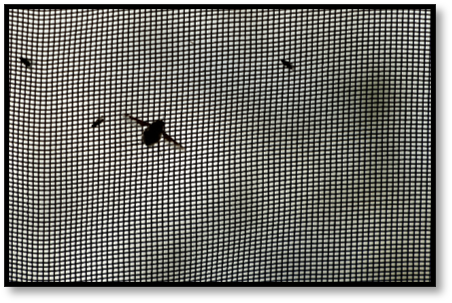 Physical – The less visible majority of the fly population is in the manure, bedding and feed. Flies reproduce in wet areas; therefore, moisture management is critical. Removing wet organic material 2x per week is recommended. Moisture management includes leak prevention under water lines, ventilation for air circulation, and absorbent bedding such as coarse sawdust. Use of fine mesh on the air intakes, doors and windows prevent flies entering the barn (screen hole size between 0.88 to 1.22 mm or 0.03 to 0.05 inches). Dead birds and broken eggs must be removed daily. Do not store manure near the barn as it may attract adult flies. Store in a separate area and compost the manure using a tarp to raise the temperature to 50⁰C (120⁰F) that will kill fly eggs and larvae. Turn the pile every 3-4 days. Keep the grass around the barn short to remove shelter for the flies and maintain good airflow.
Physical – The less visible majority of the fly population is in the manure, bedding and feed. Flies reproduce in wet areas; therefore, moisture management is critical. Removing wet organic material 2x per week is recommended. Moisture management includes leak prevention under water lines, ventilation for air circulation, and absorbent bedding such as coarse sawdust. Use of fine mesh on the air intakes, doors and windows prevent flies entering the barn (screen hole size between 0.88 to 1.22 mm or 0.03 to 0.05 inches). Dead birds and broken eggs must be removed daily. Do not store manure near the barn as it may attract adult flies. Store in a separate area and compost the manure using a tarp to raise the temperature to 50⁰C (120⁰F) that will kill fly eggs and larvae. Turn the pile every 3-4 days. Keep the grass around the barn short to remove shelter for the flies and maintain good airflow.
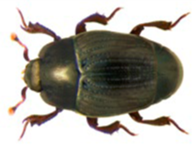
Biological – There are various organisms (e.g. beetles, mites, wasps, micro-organisms) that prey on flies that could be introduced as a component of a fly control program, especially on organic farms. Some of these organisms can also carry and transfer poultry diseases. Careful consideration must be made regarding whether and how to introduce these pests to prevent new problems from developing.
Chemical – There are 4 basic types of insecticide fly control: larvicides, residual adulticides, baits and contact adulticides. If used, follow the label instructions, refer to the Materials Safety Data Sheet (MSDS) and use personal protective equipment (PPE) as required. Some fly control products require Ontario Pesticide Certification. For more information on Ontario Pesticide Certification you can visit www.ontario.ca/environment-and-energy/pesticide-licences-and-permits.
Larvicides – Contact larvicides and insect growth regulators (IGRs) can be sprayed onto maggots or applied as a granule to wet manure.
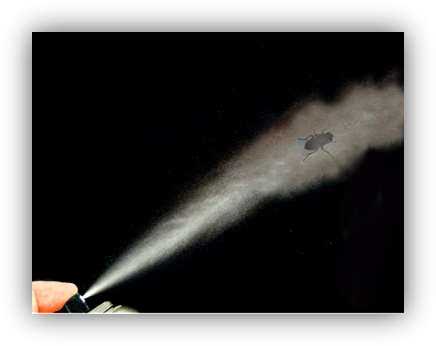 Contact adulticides – At the end of a production cycle, if there is a heavy infestation, fogging can be used to eliminate the adult flies. This should be done right after load-out to prevent the flies from hiding and reinfesting the barn after clean out. Make sure the barn is well ventilated before re-entry of personnel.
Contact adulticides – At the end of a production cycle, if there is a heavy infestation, fogging can be used to eliminate the adult flies. This should be done right after load-out to prevent the flies from hiding and reinfesting the barn after clean out. Make sure the barn is well ventilated before re-entry of personnel.
Residual adulticides – After barn clean out, apply a residual insecticide inside the barn. Disinfect first and apply insecticide as a final application. Spray the insecticide on the walls, posts and ceilings until run-off then let dry for 2-3 hours. Once dry the insecticides are not harmful to poultry or humans and are effective for 2-3 months. Spray application is more effective than fogging. . Exterior application on the outside barn walls is another option for residual insecticide. Municipal regulations and product labels must be referenced to determine if this is allowed in your area.
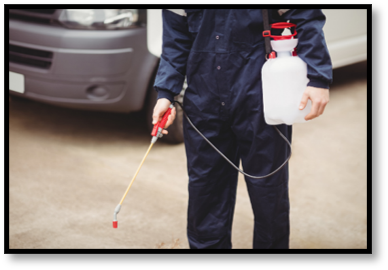 Insecticide bait – Granular bait contains insecticide, an attractant and sometimes a synthetic pheromone. Place fly bait stations throughout the barn (250g/100m2) in places where flies congregate (e.g. resting areas, windows and lights) beginning in the spring and renew once a week.
Insecticide bait – Granular bait contains insecticide, an attractant and sometimes a synthetic pheromone. Place fly bait stations throughout the barn (250g/100m2) in places where flies congregate (e.g. resting areas, windows and lights) beginning in the spring and renew once a week.
Mechanical – In non-bird areas, fly paper with adhesive or ultraviolet fly zappers may be used.
Evaluation: Keep a logbook of interventions to record methods, placement, labour, cost and to evaluate efficacy. Adjust methods as needed. Ensure rotation of insecticides with different active ingredients every 2-3 fly generations to prevent development of resistance.
Fly management needs to start early in the spring and continue throughout the summer and fall to ensure populations stay under control. If implementation of the above measures do not work then hiring a pest management company to design a program for your particular operation may be a consideration. OMAFRA Publication 849- House Fly Control in Poultry Barns is a valuable tool to help you manage fly control populations. It is free to download at: http://www.omafra.gov.on.ca/english/engineer/housefly.htm
References:
https://ag.umass.edu/crops-dairy-livestock-equine/fact-sheets/fly-control-measures
https://www.thepoultrysite.com/articles/best-practice-on-the-farm-fly-control
https://www.thepoultrysite.com/articles/fly-management-surveillance-and-control
Poultry Veterinarian Survey Highlights – Q2 2021
Broilers
Early systemic bacterial infections (<14 days) were stable to increased this quarter as reported by practitioners. Escherichia coli, Enterococcus cecorum and Clostridium perfringens were identified by practitioners. The AHL reported confirmed cases due to either E. coli or E.coli and E. cecorum.
Other causes of early mortality (<14 days) was reported as increased by one veterinarian due to clostridial enteritis. The AHL diagnosed 1 case of mycotic pneumonia at 6 days of age.
Late systemic bacterial infections (>14 days) were reported as stable to increased by the majority of practitioners this quarter with E. coli and E. coli with Enterococcus cecorum as the main causes. AHL reported increased numbers of cases attributed to E.coli, E. cecorum, or E. coli in various combinations with E. cecorum, G. anatis or C. perfringens.
Reovirus-associated lameness cases were decreased to stable by the majority of veterinarians but increased by one practitioner. AHL reported an increase in confirmed cases. A number of different genotypes were detected including Ontario variants (F, K), Ontario classic strains, and 2 Pennsylvania strains. From January 1, 2021, 40% of the reovirus isolates have been typed as the SK (Saskatchewan) variant. Further discussion with various practitioners revealed that more than one breeder flock is involved. This variant will be monitored.
Escherichia coli and E. cecorum were identified as the main causes of bacterial lameness this quarter with most practitioners reporting stable to increased prevalence.
The number of cases of nutritional and developmental lameness was reported as stable by the majority of responders, with tibial dyschondroplasia (TD) being noted.
Ascites was reported as stable to increased by the majority of veterinarians this quarter.
AHL reported an increase in bacterial osteomyelitis and tenosynovitis this quarter that were namely due to E.coli with or without E. cecorum or diagnosed on histopathology.
Coccidiosis and necrotic enteritis cases were reported as stable to increased by practising veterinarians. The AHL also reported stable coccidiosis cases, identifying the lesions in the small intestine, ceca or both. Practitioners have noted necrotic enteritis cases as early as 5 days of age.
Inclusion body hepatitis (IBH) cases were reported to be stable to increased by the majority of respondents and AHL this quarter. Genotyping on confirmed cases identified mainly FAdV8b of the species E viruses. There has been a shift in the age of affected birds to 3-4 weeks of age. This represents mainly horizontal transmission.
The number of flocks with infectious bronchitis virus (IBV) were reported as stable to increased this quarter by the majority of poultry practitioners and decreased by AHL. Practitioners see a drop in feed and water consumption followed by increased mortality. The DMV strain is most commonly identified. The Mass and Conn vaccine strains were also identified. Several cases were suspicious for IBV on histology at AHL.
Infectious bursal disease virus (IBDV) infections were reported as stable to increased this quarter by practicing veterinarians and stable by AHL.
Submissions to the AHL of confirmed runting and stunting syndrome caused by astrovirus were slightly increased this quarter. Proventricular and ventricular lesions were reported as stable to decreased respectively by AHL. Notably, there has been quite a bit of dilation reported by the pathologists who have advised veterinarians to send in cases earlier in the disease to maximize the chance of identifying a causative agent. One practitioner reported an unusual case of a barn of 4 week old birds with proventricular dilation that was associated with some mortality for a couple of days and then mortality returned to normal. The cause was unknown.
Condemnation issues were reported as stable by the majority of veterinarians this quarter and included infectious bronchitis virus and cellulitis.
Broiler-Breeders
Early systemic bacterial infections (<14 days) with and without associated yolk sacculitis were reported as stable this quarter by practitioners. E. coli continues to be the most common isolate with Pseudomonas sp. reported by one practitioner. AHL reported C. perfringens in this age group and will monitor to see if this becomes a trend.
Pre-lay mortality (> 14 days, < 20 weeks) at AHL identified S. aureus alone or in combination with E. coli and either E. cecorum or P. aeruginosa.
In-lay bacterial septicemia was reported as stable to increased by practitioners, mainly due to E. coli, G. anatis and or C. perfringens. One practitioner reported all the aforementioned organisms plus E. cecorum in the same flock as well as cystic oviduct (DMV strain). Similarly, AHL reported E.coli, S. aureus, and E. cecorum on their own or in various combinations and combined once with G. anatis.
One case of gangrenous dermatitis due to C septicum, E. coli and E. cecorum was reported by AHL.
Lameness was reported as stable by the majority of practitioners this quarter. S. aureus was the most common bacterial cause of lameness reported by practitioners and AHL along with some mixed infections with E. coli and E. cecorum. Occasionally, Pasteurella sp was isolated. It’s not unusual to isolate the vaccine strain of Pasteurella. Ruptured tendons was noted as a cause of developmental lameness by one practitioner.
IBV infections were reported as stable by the majority of practitioners and at AHL, mainly due to the DMV strain. Cystic oviducts are still being identified.
The number of coccidiosis and necrotic enteritis cases reported by the majority of practitioners was stable this quarter.
White chick syndrome (WCS) was reported by one practitioner in birds with variable hatchability. AHL also reported one case of WCS.
AHL reported one case of Histomoniasis.
Poultry practitioners reported a variety of Salmonella isolates including S. Kiambu and S. Livingstone. Salmonella enterica was isolated at the AHL in a case of bacterial tenosynovitis.
A case of vasitis (inflammation of the vas deferens) was noted by AHL. The testicles were normal and producing sperm. The cause was not identified.
AHL reported seeing an increase in neoplastic conditions in older laying birds with this trend noticed over the last 1 to 2 quarters. No significant viruses of concern have been identified but the situation will be monitored
Layers
Bacterial peritonitis/salpingitis due to E. coli, G. anatis and E. cecorum was stable.
AHL reported a few of cases of omphalitis, septicemia, and yolk sacculitis (diagnosed on histology).
Early systemic bacterial infections (<14 days) were stable to increased by practitioners and AHL mainly due to E.coli. One practitioner reported an issue with E.coli septicemia related to a contaminated HVAC system which was quickly identified and rectified.
Cases of pre-lay mortality (>14 days, < 20 weeks) at AHL identified E. coli with or without E. cecorum. Bacterial infections often increase in the spring due to changes in ventilation and outside temperature. The change from conventional to more extensive housing also provides more bacterial exposure to the birds and may contribute to the uptick in cases.
AHL reported two cases of mycotic pneumonia. One was due to Penicillium sp. and 1 was diagnosed on histology.
Focal duodenal necrosis (FDN) was reported as stable by practitioners. AHL reported one case diagnosed by histology.
IBV was reported as stable to increased by practitioners and AHL reported two pathology cases; one PCR positive and 1 suspicious on histology. Additional samples submitted to AHL Virology identified CU82792 and IBV_CA-1737_04_ON_12-025379. An increase in respiratory signs due to IBV is not unusual during springtime due to the change in ventilation and air flow patterns as well as humidity.
Necrotic enteritis and coccidiosis cases were reported as stable by practitioners.
Turkeys
Early systemic bacterial infection <14d were stable to decreased. E.coli and Salmonella sp. were reported by practitioners.
Other causes of early mortality < 14d were stable this quarter. Dehydration was listed as a cause.
Late systemic bacterial infection >14d were stable to decreased with E. coli being reported by practitioners. AHL reported an increase in submissions with isolation of E.coli or E.coli with other bacteria (S. aureus, S. gallolyticus, E. cecorum, P. aeruginosa).
ORT was reported as stable to decreased by practitioners.
Necrotic enteritis and coccidiosis were reported as stable to decreased by practitioners. One practitioner noted an increase in necrotic enteritis in their practice and one practitioner noted cases at 3 weeks of age.
Enteritis was reported as stable this quarter by practitioners.
There were 2 cases of aortic ruptures in older toms (12-13 weeks). Mortality spiked for a week then returned to normal. Another practitioner reported aortic ruptures in 7 week old toms associated with high sodium levels in the feed.
Practitioners also reported some cases of clostridial dermatitis, osteomyelitis, and tibial dyschondroplasia.
Veterinarians and AHL reported tenosynovitis due to reovirus was stable to decreased this quarter. Turkey_PA_00659_14_genotype2 continues to be reported.
Poultry practitioners reported a variety of Salmonella isolates including S. Bredeney, S. Hadar, S. Uganda, S. Schwarzengrund, S. Senftenberg, S. Infantis, S. Montevideo, S. Liverpool and S. Albany.
Rural/Backyard/Non-Quota Flocks
AHL continues to receive increasing submissions from backyard flocks. The number of backyard/urban poultry has increased due to COVID-19.
Marek’s disease continues to be diagnosed.
Three cases of ILT were diagnosed by AHL; 2 were vaccine-like and 1 was too weak to type. The virology lab had 5 PCR positive cases; 3 vaccine-like, 1 Niagara-like and 1-too weak to type.
One practitioner reported a significant problem with mites and lice in the spring. Northern fowl mite will kill birds if the infestation are high. Scaly leg mites and chicken lice are prevalent.
AHL reported a large variety of diagnoses; necrotic enteritis, coccidiosis, several birds with tumours, reproductive issues (egg bound, salpingitis), occasional bacterial septicemia, urate nephrosis, nephritis and ascites.
Botulism was diagnosed in a pheasant flock.
An increase in water fowl cases were reported by AHL with a variety of diagnoses: nephropathy, cloacitis, septicemia and gout.
One case each of aortic rupture and cellulitis (wattles) in backyard turkeys was reported by AHL.
Vaccine clinics are being offered by one clinic. Birds are delivered “curbside” to minimize human contact and bird mixing. Vaccinations against Marek’s, ILT, Cocci, Salmonella, E.coli, Newcastle and IBV are offered depending on age. Breeders are also vaccinating against Marek’s/ILT. For more information contact: Dr. Mike Petrik at petrikvet@gmail.com
Events and News
Poultry Industry Council events: https://www.poultryindustrycouncil.ca/events
Poultry Health Research Network information, events, and lectures can be accessed on the PHRN website: https://phrn.net/ or on the PHRN YouTube channel: https://www.youtube.com/user/PoultryHRN
Thank You!
We thank the following poultry veterinarians who completed the veterinary survey: Dr. Elizabeth Black, Dr. Peter Gazdzinski, Dr. Shahbaz Haq, Dr. Geneviève Huard, Dr. Anastasia Novy, Dr. Mike Petrik, Dr. Joanne Rafuse, Dr. Kathleen Sary, Dr. Ben Schlegel, Dr. Chanelle Taylor, Dr. Lloyd Weber, Dr. Alex Weisz, and Dr. Jessalyn Walkey.
